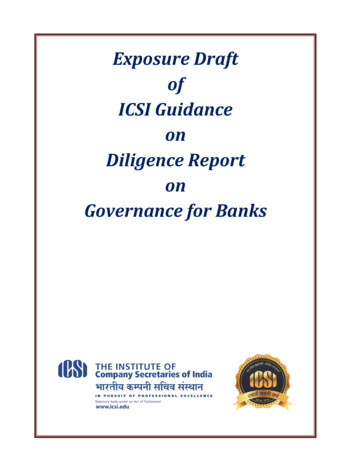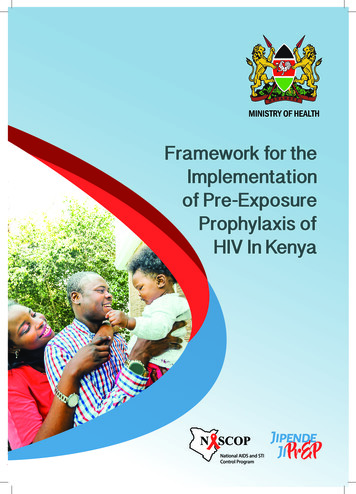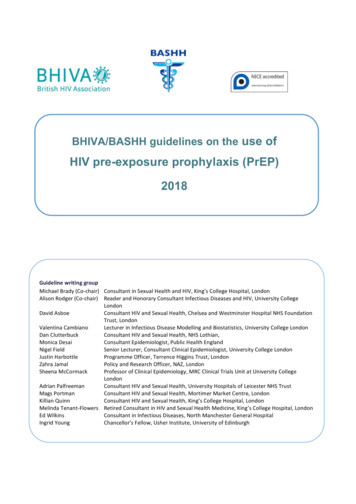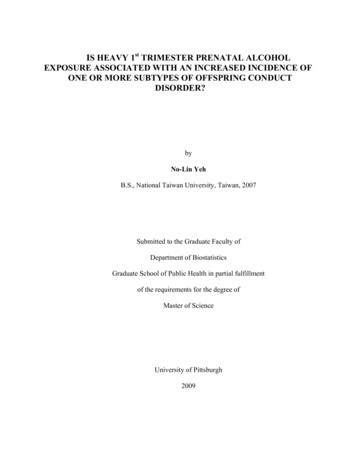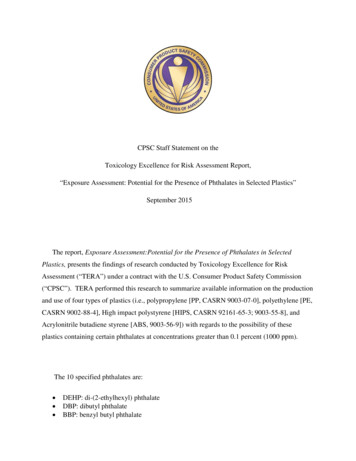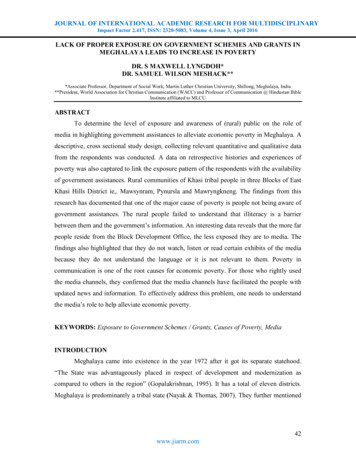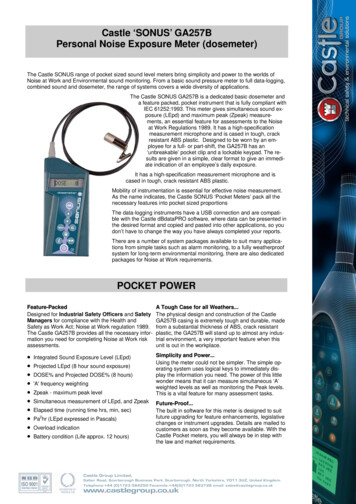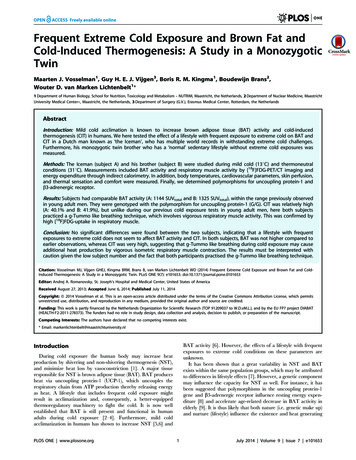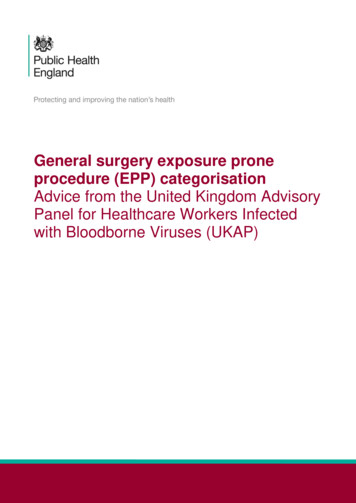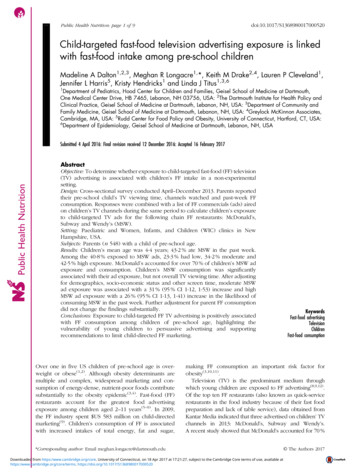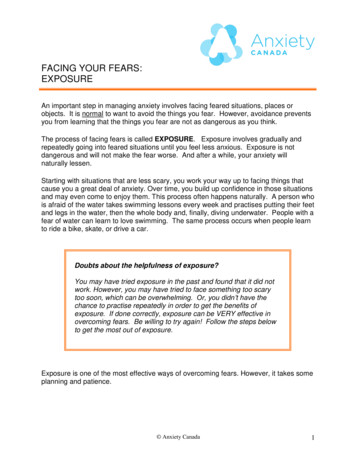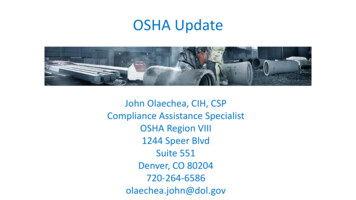
Transcription
OSHA UpdateJohn Olaechea, CIH, CSPCompliance Assistance SpecialistOSHA Region VIII1244 Speer BlvdSuite 551Denver, CO 80204720-264-6586olaechea.john@dol.gov
Denver AO - 303-844-5285Englewood AO303-843-4500
What Can We Expect? Emphasis Program OverviewNew Silica Standard and Emphasis ProgramSelect Chemical Hazard Emphasis ProgramsCOVID-19/Respirator ProtectionQuestions
National and Regional EmphasisPrograms
FY 20 NEPsAmputations in Manufacturing (Extended)Lead Exposures (GI and Construction)Federal Agency Targeting Inspection ProgramHexavalent Chromium ExposuresProcess Safety ManagementCombustible DustTrenching and Excavation (Updated)Primary Metals Industries (Foundries)ShipbreakingRespirable Crystalline Silica (NEW)Site Specific Targeting (SST) 2016– https://www.osha.gov/dep/neps/nep-programs.html
FY 20 Regional and Local EPs(Region VIII) Regional Emphasis Programs– Fall Hazards in Construction– Roadway Work Zone Activities– Oil and Gas Industry– Grain Handling Facilities– Workplace Violence in Residential Intellectual andDevelopmental Disability Facilities– Beverage Manufacturing– Hazards in Automotive Services Local Emphasis Programs– Asbestos Abatement (Englewood)– Scrap & Recycling (Englewood)– Wood Manufacturing and Processing (Billings)– Aircraft Support and Maintenance Facilities (Englewood)
OSHA’s Respirable Crystalline Silica Rule
Final Rule Publishedon March 25, 20168
Reasons for the Rule Prior permissible exposure limits (PELs) are formulas that manyfind hard to understand Prior general industry formula PEL was about equal to 100 µg/m3;construction/shipyard formulas were about 250 µg/m3 Previous PELs do not adequately protect workers Extensive epidemiologic evidence that lung cancer and silicosisoccur at exposure levels below 100 µg/m39
Exposure and Health RisksExposure to respirable crystallinesilica has been linked to: Silicosis; Lung cancer; Chronic obstructive pulmonarydisease; Kidney diseaseHealthy LungSilicotic Lung10
Health BenefitsOSHA estimates that once the effects of the ruleare fully realized, it will prevent: More than 600 deaths per year Lung cancer: Silicosis and other non-cancerlung diseases: End-stage kidney disease:124325193 More than 900 new silicosis cases per year11
Scope of Coverage Three forms of silica: quartz,cristobalite and tridymite Exposures from chipping,cutting, sawing, drilling,grinding, sanding, andcrushing of concrete, brick,block, rock, and stoneproducts (such as inconstruction operations) Exposures from using sandproducts (such as glassmanufacturing, foundries,and sand blasting)12
Industries and Operations with Exposures ConstructionGlass manufacturingPottery productsStructural clayproductsConcrete productsFoundriesDental laboratoriesPaintings and coatingsJewelry productionRefractory productsAsphalt products LandscapingReady-mix concreteCut stone and stone productsAbrasive blasting in:o Maritime worko Constructiono General industry Refractory furnaceinstallation and repair Railroads Hydraulic fracturing for gasand oil13
Workers and Industries Affected 2.3 million workers: Construction: 2 million GI/Maritime:300,000 676,000 establishments Construction:600,000 GI/Maritime:76,00014
Construction(a) Scope(b) Definitions(c) Specified exposure control methodsOR(d) Alternative exposure control methods PEL Exposure Assessment Methods of Compliance(e) Respiratory protection(f) Housekeeping(g) Written exposure control plan(h) Medical surveillance(i) Communication of silica hazards(j) Recordkeeping(k) Dates15
Example of Table 1 EntryEquipment/ TaskEngineering and Work PracticeControl MethodsHandheldpower saws(any bladediameter)Use saw equipped with integratedwater delivery system thatcontinuously feeds water to theblade.RequiredRespiratoryProtection andMinimum APF 4hr/shift 4hr/shiftNoneAPF 10APF 10APF 10Operate and maintain tool inaccordance with manufacturers’instruction to minimize dust- When used outdoors- When used indoors or in anenclosed area16
National Emphasis Program forRespirable Crystalline Silica (RCS) NEP for Respirable Crystalline Silica (RCS-NEP) Published on February 5, 2020 To enforce the 2016 Silica standards And target industries with the greatest number ofexposed workers Goals Reduce or eliminate worker exposures to respirablecrystalline silica (RCS) in general industry,construction, and maritime Annually do 2% of federal inspections (600 - 700)17
National EmphasisProgram for RespirableCrystalline Silica (RCS) NEP for RCS: Inspections to start May 5, 2020 90 day outreach period – contact John Olaechea(olaechea.john@dol.gov) for more information
Silica Directive Summary Identify tasks where anticipated exposures can exceed AL Conduct employee exposure assessmentsor follow Table 1 (for Construction) Establish written exposure control planand designate competent person (Construction) Implement feasible dust controls to reduce exposures Require use of respiratory protection if exposures exceed PEL Prohibit use of compressed air and dry sweeping for cleaning Offer medical surveillance as required to employees that wearrespiratory protection Train employees on hazards and control methods Maintain records
Silica:Table 1 Request for Information RFI published in the FederalRegister on August 15, 2019 Agency requested information andcomment on: Additional controls for taskscurrently on Table 1 Additional tasks to add Allowing employers covered byGI standard to followconstruction standard inadditional circumstances22
Small EntityCompliance Guides Available for .pdfandgeneral 1.pdf Explain theprovisions of thestandards
Outreach and Guidance MaterialsOSHA Safety and Health Topics ine/index.html
Frequently AskedQuestions Available for bothconstruction andgeneral industry/maritime Provide responses tosome of the mostcommon stakeholderquestions
Videos Fact Sheets Training PowerPoint Template
Other Guidance Materials NIOSH Silica Safety and Health Topics– https://www.cdc.gov/niosh/topics/silica/ CPWR Silica Safe Website– http://www.silica-safe.org/ Tool Manufacturers– Instructional Videos– Operator Manual
Guidance and Outreach Center forConstruction Researchand Training (CPWR)– E-tool to: Assess silicahazards Select controls Create a plan28
29PSM Covered Chemical FacilitiesNEP Released 2017 Updated to include refineries– Refinery inspections distributed based on total number perregion Four targeting categories– Ammonia refrigeration – 25 percent– Refineries – based on total per region– Chemical facilities (NAICS 325) – 45 percent– Other – 30 percent
What is covered by PSM? Processes including:– 10,000 pounds of flammable liquids or gasses– Threshold quantity (TQ)of a highly hazardous chemical (HHC) 130 chemicals listed in Appendix A Toxic and/or reactive chemicals
ChemNEP Citations by PSM ElementElementDescription% of PSMCitationsCum %jMechanical Integrity26.926.9dProcess Safety Information19.649.2eProcess Hazard Analysis15.364.5fOperating Procedures10.574.9lManagement of Change5.280.1hContractors4.784.9oCompliance Audits3.688.5nEmergency Response and Planning3.491.9gTraining3.295.1cEmployee Participation2.197.2mIncident Investigation1.398.5iPre-startup Review1.1kHot Work0.43199.6100
Combustible Dust NEP Hazards created when:– Dust is combustible– Dust is dispersed in air and concentration is aboveMEC (min explosible conc)– Ignition source exists– Confinement
Combustible Dust NEP Combustible dusts include:– Metal, wood, coal/carbon, plastics, organic dusts Industries include:– Agriculture, food, chemicals, textiles, metals, tires,pharmaceuticals, paper, recycling, coal
Combustible Dust NEP National Emphasis Program Citable under:– 1910.176 (housekeeping)– 1910.94 (ventilation)– General Duty Clause (Section 5a1) General Duty Clause:–––––NFPA 654 (prevention of fire)NFPA 484 (combustible metals)Operator’s manualIndustry practicesOther consensus standards
Combustible Dust
Protecting the Safety and Health of WorkersCoronavirus Disease 2019 (COVID-19)
OSHA enforcementOSHA:OSHA enforcement authority Typically responds to emergencies, including diseaseoutbreaks, in a technical assistance posture. During emergency response operations,even when OSHA is operating in a technicalassistance and support mode, OSHAstandards remain in effect and OSHAretains its ability to enforce the OSHAstandards under the OSH Act. Enforcement of OSHA standards followsthe jurisdiction in place before theemergency, such as in states operatingOSHA-approved occupational safety andhealth programs called State Plans. Provides compliance assistance to employers to help ensureworkers are protected. Provides technical assistance and support to other federalagencies, as well as state/local partners. Implemented interim enforcement plan for investigatingCOVID complaints, while ensuring the safety of workers,employers, and inspectors.www.osha.gov/coronavirus
Existing OSHA standards protectworkers from exposureRelevant OSHA requirements Follow existing OSHA standards to help protectworkers from exposure to SARS-CoV-2 and infectionwith COVID-19. Employers should also remember that OSHA can usethe General Duty Clause, Section 5(a)(1), of theOccupational Safety and Health Act to ensure thatworkers are protected from recognized safety andhealth hazards that may cause serious harm.www.osha.gov/coronavirusPersonal Protective Equipment (29 CFR1910 subpart I), including: PPE General Requirements (1910.132)Eye and Face Protection (1910.133)Respiratory Protection (1910.134)Hand Protection (29 CFR 1910.138)Bloodborne Pathogens (29 CFR 1910.1030)Hazard Communication (29 CFR 1910.1200)Recordkeeping (29 CFR part 1904)
OSHA enforcement discretionOSHA has provided enforcementdiscretion for some of itsrequirements, including: Respiratory Protection standard(29 CFR 1910.134) Other health standards withrespirator requirements Recording and ReportingOccupational Injuries and Illness(29 CFR Part 1904)MemorandumEffectiveHealthcare Respiratory Protection Annual Fit-Testing for N95 Filtering FacepiecesDuring the COVID-19 OutbreakMarch 14, 2020 presentEnforcement Guidance for Respiratory Protection and the N95 Shortage Due to the2019 Novel Coronavirus Disease (COVID-19) PandemicApril 3, 2020 –presentEnforcement Guidance for Use of Respiratory Protection Equipment Certified UnderStandards of Other Countries or Jurisdictions During the COVID-19 PandemicApril 3, 2020 presentExpanded Temporary Enforcement Guidance on Respiratory Protection Fit-Testingfor N95 Filtering Facepieces in All Industries During the COVID-19 PandemicApril 8, 2020 presentEnforcement Guidance for Recording Cases of Coronavirus Disease 2019 (COVID-19)April 10, 2020 –presentEnforcement Guidance on Decontamination of Filtering Facepiece Respirators inHealthcare During the COVID-19 PandemicApril 24, 2020 –presentwww.osha.gov/coronavirus
OSHA Guidance: RecordingWork-Related COVID-19 Cases COVID-19 can be a recordable illness, and employers are responsible for recording casesof COVID-19 if all of the following are met:o The case is a confirmed case of COVID-19 (see CDC information on persons under investigationand presumptive positive and laboratory-confirmed cases of COVID-19);o The case is work-related, as defined by 29 CFR 1904.5; ando The case involves one or more of the general recording criteria set forth in 29 CFR 1904.7 (e.g.,medical treatment beyond first aid, days away from work). OSHA is exercising enforcement discretion around recording COVID-19 cases.www.osha.gov/coronavirus
OSHA guidance OSHA has developed a variety ofguidance materials for workers andemployers on how to stay healthyduring the pandemic. OSHA.gov/coronavirus includesinformation on implementing thehierarchy of controls when workers havespecific exposure risks.www.osha.gov/coronavirus
OSHA guidanceOSHA Alerts COVID-19 Guidance for the Construction Workforce COVID-19 Guidance for the Manufacturing IndustryWorkforce COVID-19 Guidance for the Package Delivery Workforce COVID-19 Guidance for Retail Workers Prevent Worker Exposure to Coronavirus (COVID-19)www.osha.gov/coronavirus
OSHA Compliance Assistance Regional ComplianceAssistance Newsletter Send request toolaechea.john@dol.gov tosubscribe
Questions?John Olaechea, CIH, CSPCompliance Assistance SpecialistOSHA Region VIII1244 Speer BlvdSuite 551Denver, CO 80204720-264-6586olaechea.john@dol.gov
DISCLAIMER This information has been developed by an OSHA Compliance Assistance Specialist and is intended toassist employers, workers, and others improve workplace health and safety. While we attempt tothoroughly address specific topics, it is not possible to include discussion of everything necessary toensure a healthy and safe working environment in this presentation. This information is a tool foraddressing workplace hazards, and is not an exhaustive statement of an employer’s legal obligations,which are defined by statute, regulations, and standards. This document does not have the force andeffect of law and is not meant to bind the public in any way. This document is intended only to provideclarity to the public regarding existing requirements under the law or agency policies. It does not create(or diminish) legal obligations under the Occupational Safety and Health Act. Finally, OSHA may modifyrules and related interpretations in light of new technology, information, or circumstances; to keepapprised of such developments, or to review information on a wide range of occupational safety andhealth topics, you can visit OSHA’s website at www.osha.gov.
www.osha.gov1-800-321-OSHA (6742)
OSHA Update John Olaechea, CIH, CSP Compliance Assistance Specialist OSHA Region VIII 1244 Speer Blvd Suit
